
Guava is a common tropical fruit cultivated in many tropical and subtropical regions. The common guava Psidium guajava is a small tree in the myrtle family (Myrtaceae), native to Mexico, Central America, the Caribbean and northern South America. The name guava is also given to some other species in the genus Psidium such as strawberry guava and to the pineapple guava, Feijoa sellowiana. In 2019, 55 million tonnes of guavas were produced worldwide, led by India with 45% of the total. Botanically, guavas are berries.

Psidium is a genus of trees and shrubs in the family Myrtaceae. It is native to warmer parts of the Western Hemisphere.

The pink pigeon is a species of pigeon in the family Columbidae endemic to Mauritius. The pink pigeon nearly became extinct in the 1970s and the 1990s and is still very rare. It is the only Mascarene pigeon that has not become extinct. It was on the brink of extinction in 1991 when only 10 individuals remained, but its numbers have increased due to the efforts of the Durrell Wildlife Conservation Trust since 1977. While the population remains at below 500 birds as of 2011, the IUCN downlisted the species from Critically endangered to Endangered on the IUCN Red List in 2000, and then downlisted it again to Vulnerable in 2018.
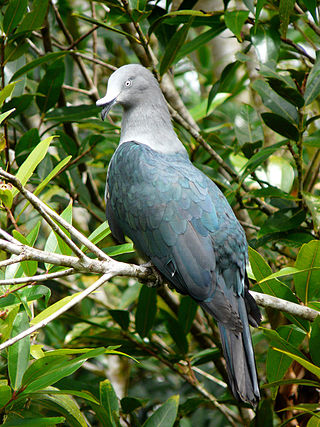
The Marquesan imperial pigeon, also known as the Nukuhiva pigeon or Upe, is a pigeon which is endemic to Nuku Hiva in the Marquesas Islands of French Polynesia. This pigeon is only found in some valleys in the western part of that island.

Psidium cattleyanum , commonly known as Cattley guava, strawberry guava or cherry guava, is a small tree in the Myrtaceae (myrtle) family. The species is named in honour of English horticulturist William Cattley. Its genus name Psidium comes from the Latin psidion, or "armlet." The red-fruited variety, P. cattleyanum var. cattleyanum, is commonly known as purple guava, red cattley guava, red strawberry guava and red cherry guava. The yellow-fruited variety, P. cattleyanum var. littorale is variously known as yellow cattley guava, yellow strawberry guava, yellow cherry guava, lemon guava and in Hawaii as waiawī. Although P. cattleyanum has select economic uses, it is considered the most invasive plant in Hawaii.

Humblot's flycatcher or the Grand Comoro flycatcher, is a small passerine bird belonging to the Old World flycatcher family. It is the only member of its genus. Humblot's flycatcher is endemic to the island of Grand Comoro in the Comoros where it inhabits forest on the slopes of Mount Karthala. The scientific name commemorates the French naturalist Léon Humblot.
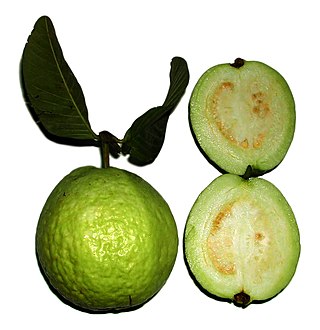
Psidium guajava, the common guava, yellow guava, lemon guava, or apple guava is an evergreen shrub or small tree native to the Caribbean, Central America and South America. It is easily pollinated by insects; when cultivated, it is pollinated mainly by the common honey bee, Apis mellifera.
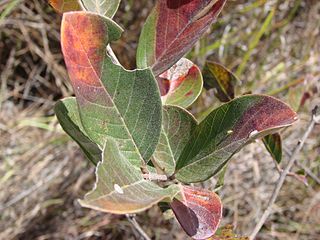
Psidium cinereum, called katuaba, is a species of plant in the family Myrtaceae. It is endemic to Brazil. It is becoming rare due to habitat loss. A relative of guava, it is sometimes used in herbal concoctions.
Psidium harrisianum is a species of plant in the family Myrtaceae. It is endemic to Jamaica.
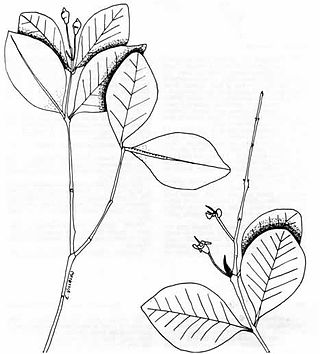
Psidium sintenisii is a species of flowering plant in the myrtle family, Myrtaceae. It is endemic to Puerto Rico, where it is known from three or four small subpopulations, mainly within El Yunque National Forest. It grows in wet mountain forest habitat. Its common names are Sintenis' guava and hoja menuda.
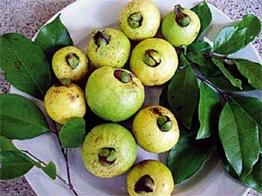
Psidium friedrichsthalianum, the Costa Rican guava or cas, is a species of guava found mostly in Costa Rica but also grown in Guatemala, Nicaragua and other Central American countries. It can be found in Nicaragua as "guava juice" or "fresco de guava". This fruit is commonly used to prepare a sour and refreshing drink. It has been successfully grown in California now and can be grown from seed in mild higher regions.

Phocides polybius, the bloody spot or guava skipper, is a species of butterfly in the skipper family, Hesperiidae, that is native to the Americas. It is found from the lower Rio Grande Valley of southern Texas in the United States south through Mexico and Central America to Argentina. The species was first described by Johan Christian Fabricius in 1793.
Euphorbia deppeana is a rare species of flowering plant in the family Euphorbiaceae known by the common names Deppe's broomspurge and Oahu sandmat. It is endemic to Oʻahu, Hawaii, where it is known from only one population in moist shrublands on Nuʻuanu Pali. Like other native Hawaiian euphorbs it is called ʻakoko locally.
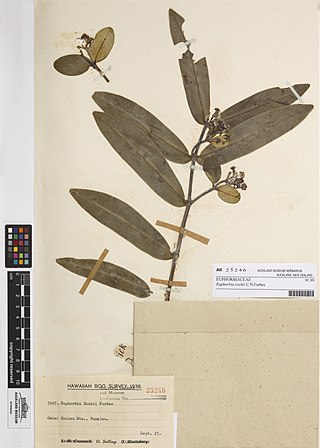
Euphorbia rockii is a rare species of flowering plant in the euphorb family known by the common names Koolau Range sandmat and Rock's broomspurge. It is endemic to Oʻahu, Hawaii, where it is known only from the Koʻolau Mountains. There are 200 to 300 plants remaining. Like other Hawaiian euphorbs, this plant is known locally as ʻakoko.
Guava are a type of tropical fruit, commonly from the species Psidium guajava, the "common guava". Guava may also refer to:
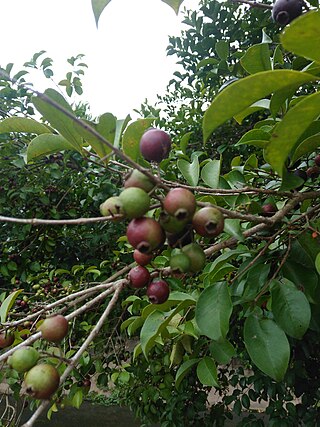
Psidium rufum is commonly known as the purple guava. It is endemic to Brazil and bears an edible fruit. Psidium rufum var. widgrenianum is listed on the IUCN Red List vulnerable species (Plantae).
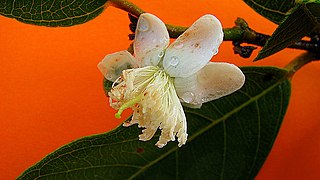
Psidium guineense is a species of guava.

Myrteae is the largest tribe in the plant family Myrtaceae. It includes most of the species of the family that have fleshy fruits.
Psidium sartorianum is a species of tree in the family Myrtaceae. It is native to North and South America. In much of Mexico it is called guayabillo; the Maya call it niedenzu and pichi' che' . In English it is called little guava. P. sartorianum is described as producing fruits up to an inch in diameter (2.5 cm) -- much smaller than the cultivated guava -- but tasting something like regular guava fruits.















